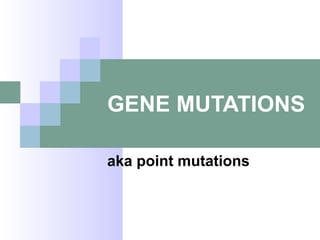Gene mutations
- 1. GENE MUTATIONS aka point mutations
- 2. DNA sequence Ōåō mRNA sequence Ōåō Polypeptide Gene mutations which affect only one gene Transcription Translation
- 3. DNA (antisense strand) mRNA Polypeptide Normal gene GGTCTCCTCACGCCA Ōåō CCAGAGGAGUGCGGU Codons Ōåō Pro-Glu-Glu-Cys-Gly Amino acids The antisense strand is the DNA strand which acts as the template for mRNA transcription
- 4. Mutations: Substitutions Substitution mutation GGTCACCTCACGCCA Ōåō CCAGUGGAGUGCGGU Ōåō Pro-Arg-Glu-Cys-Gly Substitutions will only affect a single codon Their effects may not be serious unless they affect an amino acid that is essential for the structure and function of the finished protein molecule (e.g. sickle cell anaemia) Normal gene GGTCTCCTCACGCCA Ōåō CCAGAGGAGUGCGGU Codons Ōåō Pro-Glu-Glu-Cys-Gly Amino acids
- 5. The genetic code is degenerate A mutation to have no effect on the phenotype Changes in the third base of a codon often have no effect.
- 6. No change Normal gene GGTCTCCTCACGCCA Ōåō CCAGAGGAGUGCGGU Codons Ōåō Pro-Glu-Glu-Cys-Gly Amino acids Substitution mutation GGTCTTCTCACGCCA Ōåō CCAGAAGAGUGCGGU Ōåō Pro-Glu-Glu-Cys-Gly
- 7. Disaster Normal gene GGTCTCCTCACGCCA Ōåō CCAGAGGAGUGCGGU Codons Ōåō Pro-Glu-Glu-Cys-Gly Amino acids Substitution mutation GGTCTCCTCACTCCA Ōåō CCAGAAGAGUGAGGU Ōåō Pro-Glu-Glu-STOP
- 8. Mutations: Inversion Normal gene GGTCTCCTCACGCCA Ōåō CCAGAGGAGUGCGGU Codons Ōåō Pro-Glu-Glu-Cys-Gly Amino acids Inversion mutation GGTCCTCTCACGCCA Ōåō CCAGGAGAGUGCGGU Ōåō Pro-Gly-Glu-Cys-Gly Inversion mutations, also, only affect a small part of the gene
- 9. Mutations: Additions Normal gene GGTCTCCTCACGCCA Ōåō CCAGAGGAGUGCGGU Codons Ōåō Pro-Glu-Glu-Cys-Gly Amino acids Addition mutation GGTGCTCCTCACGCCA Ōåō CCACGAGGAGUGCGGU Ōåō Pro-Arg-Gly-Val-Arg A frame shift mutation
- 10. Mutations: Deletions Normal gene GGTCTCCTCACGCCA Ōåō CCAGAGGAGUGCGGU Codons Ōåō Pro-Glu-Glu-Cys-Gly Amino acids Deletion mutation GGTC/CCTCACGCCA Ōåō CCAGGGAGUGCGGU Ōåō Pro-Gly-Ser-Ala-Val A frame shift mutation
- 11. Mutations of haemoglobin ’ü« Haemoglobin is a tetramer = 2 ╬▒ and 2 ╬▓-chains ’ü« The genes for these polypeptides are found on different chromosomes ’ü« The ╬▓-chain gene is found on chromosome 11 ’ü« The ╬▒-chain gene is found on chromosome 16 ’ü« The nucleotide sequences have been worked out ’ü« Several inherited diseases occur on the ╬▓-chain, which contains 146 amino acids.
- 12. ╬▓ haemoglobin sense strand cDNA sequence ’ü« cDNA (complementary DNA) is obtained by back-transcribing the mRNA used to translate the polypeptide ’ü« So cDNA has no introns ’ü« This is done using reverse transcriptase enzyme.
- 13. ATG GTG CAT CTG ACT CCT GAG GAG AAG TCT GCC GTT ACT GCC CTG TGG GGC AAG GTG AAC GTG GAT GAA GTT GGT GGT GAG GCC CTG GGC AGG CTG CTG GTG GTC TAC CCT TGG ACC CAG AGG TTC TTT GAG TCC TTT GGG GAT CTG TCC ACT CCT GAT GCT GTT ATG GGC AAC CCT AAG GTG AAG GCT CAT GGC AAG AAA GTG CTC GGT GCC TTT AGT GAT GGC CTG GCT CAC CTG GAC AAC CTC AAG GGC ACC TTT GCC ACA CTG AGT GAG CTG CAC TGT GAC AAG CTG CAC GTG GAT CCT GAG AAC TTC AGG CTC CTG GGC AAC GTG CTG GTC TGT GTG CTG GCC CAT CAC TTT GGC AAA GAA TTC ACC CCA CCA GTG CAG GCT GCC TAT CAG AAA GTG GTG GCT GGT GTG GCT AAT GCC CTG GCC CAC AAG TAT CAC TAA Methionine initiator Nonsense terminator
- 14. Mutation Codon Change to DNA sense strand Change in Amino Acid S (sickle cell anaemia) 6 GAG to GTG Glu to Val C (cooleyŌĆÖs syndrome) 6 GAG to AAG Glu to Lys GSan Jose 7 GAG to GGG Glu to Gly E 26 GAG to AAG Glu to Lys MSaskatoon 63 CAT to TAT His to Tyr MMilwauki 67 GTG to GAG Val to Glu OArabia 121 GAA to GTA Glu to Val
- 15. Sickle Cell Anaemia Blood smear (normal) Image Credit: http://lifesci.rutgers.edu/~babiarz/ Sickle cell anemia Image Credit: http://explore.ecb.org/














